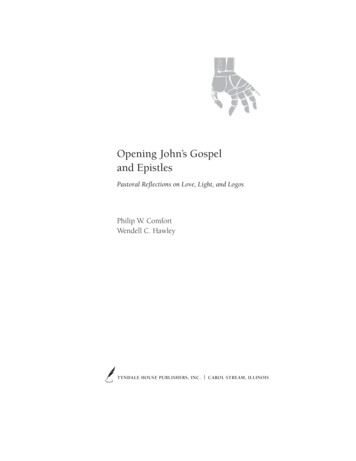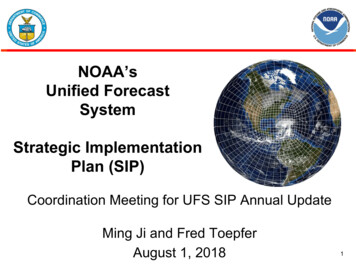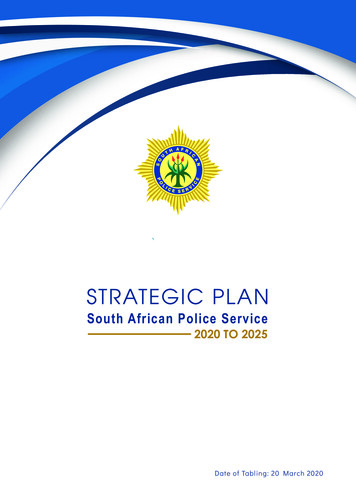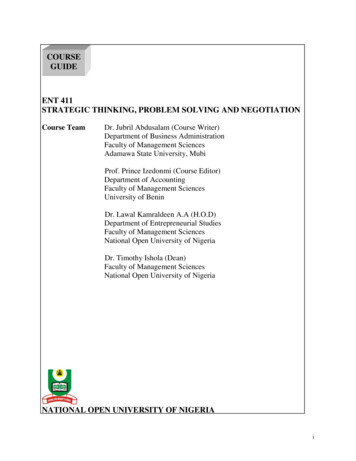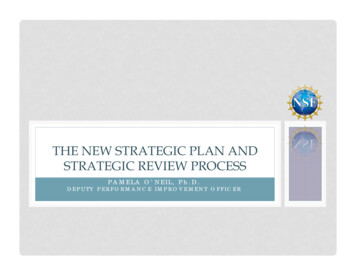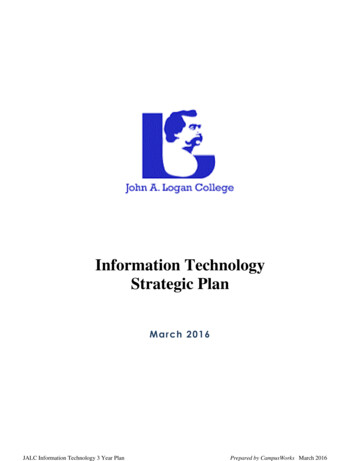
Transcription
Information TechnologyStrategic PlanMarch 2016JALC Information Technology 3 Year PlanPrepared by CampusWorks March 2016
Executive SummaryJohn A. Logan College (JALC) continues to make considerable investments and advancements intechnology deployment and utilization of its technological resources. The mission and purpose of theInformation Technology Services Department (ITS) is to provide technology services and support for Faculty,Administration, Staff and Students.The Information Technology Department is led by the Executive Director Technology, who reports tothe Vice President for Business Services & College Facilities. The department has a total staff of twelve, plusadditional support from the CampusWorks and Jenzabar contracts. The twelve consists of three directors, oneexecutive director, one coordinator and support staff, plus student workers. This staff is responsible for networksupport and operations, academic computer labs, telecommunications, web services and desktop technicalsupport. The office is also responsible for administrative computing partially supported by the Jenzabar supportcontracts, including computer operations. The Jenzabar software is supported and serviced by the Jenzabar andCampusWorks contracts, which is outsourced and supports our user community reporting to the ExecutiveDirector Technology.JALC has identified the following major initiatives towards achieving its goal in supporting theCollege’s technological goals. This three year plan will work towards achieving this goal.In addition to striving and working towards staying up to date technologically, the IT Departmentis always providing the highest level of support possible to the College Community.This plan is a living document or dynamic document that is continually edited and updated. However,this plan may evolve through successive updates, be expanded as needed, and serve a different purpose overtime. Living documents are changed through revisions that may or may not reference previous iterativechanges.This document reports on the development of a strategic information technology plan for John A. LoganCollege. The purpose of the plan is to chart the direction for the development and evolution of informationtechnology infrastructure, services, and support at the College. The plan provides an outline of where theCollege aspires to be. It does not dictate specific operational solutions, but rather, provides a strategic contextwithin which operational IT decisions can be made. This formally-articulated information systems architectureserves as a set of guidelines (a “blueprint”) for making informed decisions about information systems issues,acquisitions, implementations, and ongoing support and maintenance.The plan delineates the institution’s system components across multiple inter-related layers of systems.These architectural layers are buttressed by the institution’s articulated information systems philosophy, vision,and guiding IT principles as well as by IT best practices.For each of the information system’s architectural layers, the plan sets forth strategic initiatives that willserve to guide more-detailed annual derivative tactical/operational plans. The plan concludes by summarizingthe proposed strategic initiatives, estimated budget and suggesting a target implementation timetable based onperceived priorities and prerequisite relationships, and aligns the proposed initiatives with the institutionalvision and goals.JALC Information Technology 3 Year PlanPrepared by CampusWorks March 2016
The strategic initiatives that are listed in this plan will touch on, and contribute to meeting and satisfyingthe College’s Vision and Strategic Projects, as documented in the John A. Logan College Five Year StrategicPlan FY 2014-2018 (Work In Progress).John A. Logan College Five Year Strategic Plan FY 2014-2018 (Work In Progress):Vision Attributes:#2Access:John A. Logan makes its academic programs, cultural programming, community services, grounds andfacilities, and other resources highly accessible to students and the public at large through a variety of locations,modes of delivery, access points, community events, and special services for the disadvantaged.# 28 Technology for Instructional ExcellenceJALC effectively deploys and integrates information and other technologies that advance learning and give ourstudents / graduates a competitive advantage.# 29 Technology for Operational EffectivenessJALC makes very effective use of technology to optimize the efficiency and effectiveness of College operationsand business services.Proposed Strategic Projects:#2ERP SystemAcquire and successfully implement an Enterprise Management System (ERP) that will give JALCadvanced capability to extract and use data for reporting, research and informed decision making.#3IT StaffingHire new staff and / or train existing staff to provide the competencies needed to fully exploit the capabilities ofthe new ERP system and in doing so support institutional research, reporting, and informed decision making.The strategic initiatives are as follows:Network-Related Strategic InitiativesNetwork-1: Remediate the College Network SecurityNetwork-2: Implement College-Wide Network Security Plan & RecommendationsNetwork-3: Implement a BYOD InitiativeNetwork-4: Evaluate & Implement a VoIP Telephone SystemNetwork-5: Improve the College FirewallNetwork-6: Server UpgradesNetwork-7: Data Cabling Refresh PlanNetwork-8: Fiber Backbone UpgradesJALC Information Technology 3 Year PlanPrepared by CampusWorks March 2016
Hardware-Related Strategic InitiativesHardware-1: Improve Conditions in the Data CenterHardware-2: Implement an Enterprise Storage SolutionHardware-3: Improvements to Virtual Server EnvironmentHardware-4: Inventory Replacement & Lifecycle Plan for IT InfrastructureHardware-5: Inventory Replacement & Life Cycle Plan (Users, Labs, Smart Classrooms):Hardware-6: Develop a Formal Hardware Acquisition ProcessHardware-7: Devise Charging StationsData-Related Strategic InitiativesData-1: Implement a User-Friendly Ad Hoc Reporting System (Jenzabar)Software-Related Strategic InitiativesSoftware-1: Identity Management UpgradesSoftware-2: Maximize Jenzabar CX/JXSoftware-3: Complete Software Inventory and Life CycleSoftware-4: Implement a Software Acquisition ProcessSoftware-5: Server/Service MonitoringOrganization-Related Strategic InitiativesOrganizational-1: Develop a Best Practice Support ModelOrganizational-2: Create Formal Business Continuity/Disaster Recovery PlansOrganizational-3: Complete Jenzabar DeploymentInstruction-Related Strategic InitiativesInstructional-1: Articulate Smart Classroom Design StandardsInstructional-2: Implement Smart Classroom Management ProcessInstructional-3: Investigate New Instructional TechnologiesInstructional-4: Investigate the Use of Video Conferencing College-WideInstructional-5: Relocation of Student Access Computer LabInstructional-6: Renovation of Instructional Computer LabsThese initiatives must be carefully reviewed and analyzed, estimating their costs and benefits, both tangible andintangible, determining their feasibility from operational, technical, economic, and organizational perspectives,and setting appropriate FY 2017 to FY 2019 tactical initiatives.This initial strategic information technology plan should not be viewed as an end to IT planning but rather as abeginning. It will immediately generate a one-year tactical/operation plan to guide IT acquisitions anddecisions for fiscal year 2017. The experiences gained during the implementation of that one-year operationalplan will provide feedback to further inform and shape the long-term strategic plan. The strategic plan cantherefore be adjusted annually, based on budget, funding and priorities. Minimally, it will be revisited in detailevery three years. It is thus intended to be a “living document,” responsive to the needs and aspirations of itsconstituents.JALC Information Technology 3 Year PlanPrepared by CampusWorks March 2016
Network-Related Strategic InitiativesNetwork-1: Remediate the College Network SecurityJohn A. Logan College’s (JALC) network is part of the college’s critical information systems, JALC engagedCampusWorks to assess the current network environment related to security, intrusion testing, and compliance.The assessment has been completed and a plan developed with recommended changes and/or improvements.Remediation is an ongoing effort with continuous testing and regular upgrades. CampusWorks will work withJALC IT Staff to provide continual guidance in remediating network security and assist in the testing.CampusWorks is acting as the Chief Information Security Officer (CISO) through our agreement that extendsthrough October 2017.Target Date for Completion:Estimated Budget Impact:AnnuallyNONE(Potential Financial Impact based on Findings/Remediation)Network-2: Implement College-Wide Network Security Plan & RecommendationsIn support of the goal of protecting John A. Logan College’s (JALC) vital information asset, and focused onimproving the security of the college’s critical information systems, JALC engaged CampusWorks to developand strengthen the protection utilized for the data entrusted to JALC from potential students, parents, currentsstudents, past students, adult learners, alumni, faculty and staff. CampusWorks will provide guidance to protectJALC information assets from ever-present cyber threats that affect all of the internet world. CampusWorks willprovide continual guidance in developing a unified cybersecurity framework and assist in the implementation ofthe information security plan that is based in a college-wide culture of security. CampusWorks is acting as theChief Information Security Officer (CISO) through our agreement that extends through October 2017.Target Date for Completion:Estimated Budget Impact:AnnuallyNONE(Potential Financial Impact based on Findings/Remediation)Network-3: Implement a BYOD Initiative (Policy)The purpose of this policy is to define accepted practices, responsibilities and procedures for the use ofpersonally owned mobile devices that John A. Logan (JALC) authorizes to connect to enterprise systems. Thispolicy defines the commitment requirement, provides guidance for the secure use of end-user mobile devicesand makes it clear there is no reimbursement for personal purchase of mobile endpoint devices, includingmobile phones, smartphones and media tablets.At the core of this policy is the concept that the employee, through an opt-in decision, trades control overhis/her personal device in exchange for access to corporate resources (such as the network and email). It isimportant that the consequences and obligations of this arrangement are well-understood.JALC Information Technology 3 Year PlanPrepared by CampusWorks March 2016
Mobile devices are a valuable tool in conducting business. It is critical that JALC protect and maintain usersafety, security and privacy, while simultaneously protecting enterprise information assets while using thesetools. Use of mobile devices supplied by or funded by JALC shall be primarily for enterprise business.However, JALC will permit the use of personally owned devices, subject to the following broad guidelines:The decision to be eligible to use a personally owned mobile device for organization business will be based on adocumented business need and appropriate management approval. Guidelines for eligibility need to be defined.Target Date for Completion:Estimated Budget Impact:AnnuallyNONE(Potential Financial Impact based on Software/Services)Network-4: Evaluate & Implement a VoIP Telephone SystemThe College’s IT Department supports 676 Phones, including 657 Voicemail accounts, on a daily basis. Thissystem is run on Nortel and CS1000 equipment, utilizing our network infrastructure. Frontier provides 3rd partysupport (8am – 5pm / M-F) at a cost of approximately 25,000 annually.The College’s current phone system, both hardware and software, needs to be upgraded to support the servicesneeded by the college community. The operating system is running on windows 2003, which has reached theend of useful life and does not provide any updates. The hardware and software that is supported by AVAYAhas costly upgrades, at which the college is 3 versions/releases behind, that supports the aged system. Thisleaves the College at great risk and exposure. IT may not be able to recover from a hardware or software failureon a timely basis, and would not be able to accurately, based on the type of failure, assess the cost to recover.This exposes the College to a potential outage, that they cannot recover from, nor receive support, to replace thehardware or configure and repair the software. The vendor which supports the maintenance contract for thecurrent phone system estimates it may take up to 2 weeks (No Phones) to recover from an outage or repair. Thisis due to the age of the system and the availability of replacement parts, depending on the type of outage andrepairs required.The college needs to evaluate, plan and implement a VOIP (Voice Over IP) supported system.Target Date for Completion:FY ‘18Estimated Budget Impact: 500,000.00 (Rough Estimate / One Time)Plus Annual Maintenance of new systemNetwork-5: Improve the College FirewallThe college firewall has been in place for one year. Improvements to the firewall include general tuning ofservices. Know stable firmware upgrades will be applied as needed. Application upgrades and firmwareupdates are a part of Dell’s Pro Support Plus services which are good until FY18, at which time the serviceswill be required to be renewed in order to continue up to date virus, malware, and know cyber threat protection.Required internal audits of the systems configuration shall be enacted to provide assurances that JALC’snetwork resources are not inadvertently exposed either by malicious intent or un-intentional misconfigurations.As more and more resources are utilized by hosted or cloud resources, it is imperative the requests for newservices at JALC which require the College Firewall to be undergo configuration changes, that those changesare not made without thorough review of risk versus benefit has been requested and approved.Target Date for Completion:AnnuallyEstimated Budget Impact: 5,000.00JALC Information Technology 3 Year PlanPrepared by CampusWorks March 2016
Network-6: Server UpgradesWhether physical or virtual server, JALC’s data center on campus is a vital piece of the infrastructure whichhold vital and secure data, as well as all authentication user accounts. Server upgrades are to be maintained toinsure that sufficient compute and storage space is available for JALC vital backups both on site and off site.With this plan IT shall monitor EOL timelines for Operating Systems to insure that security and vulnerabilitypatching is always an option. Non supported legacy systems will be upgraded or removed from theinfrastructure. Risk to JALC can be mitigated by planning for yearly refreshes of equipment that supports vitalinfrastructure and services.Target Date for Completion:AnnuallyEstimated Budget Impact: 75,000.00Network-7: Data Cabling Refresh PlanSupporting data reliant technologies relies more on a solid infrastructure. Data cabling in many of JALC’sareas is running on older copper in which in appropriate installation was performed, or code violations exist.The plan would be to assess existing copper data cables, and plan for their reinstallation with up to date andcompliant data cables.Target Date for Completion:Annually (Estimated 3 to 4 years)Estimated Budget Impact: 50,000.00 (Annually)Network-8: Fiber BackboneFiber Optics are what delivers the network (Wired/Wireless) across JALC’s main campus. Many of theNetwork Closets are connected with OM1 Multi Mode fiber which was designed to handle 100Mb/secbandwidths. Issues are continuous with the existing Fiber, which was installed in 1994. JALC’s switches nowsupport 10Gb/sec speeds with redundant connections. Known issues with our switch closets connections willbe remediated be installing a standards compliant Fiber Backbone which is to be designed not only to addresstoday’s needs, but tomorrows as well.Target Date for Completion:FY ’18 – FY ‘19Estimated Budget Impact: 250,000.00Hardware-Related Strategic InitiativesHardware-1: Improve Conditions in Data CenterThe JALC Data Center hold most of the college’s critical infrastructure. Controlling physical access will bepriority one, by replacing door locks accessible by JALC’s A key, and providing a mechanism for auditingaccess to the room. Other improvement such as better labeling and cable management will provide a betterworking environment, and insure that the college’s access to resources in not in adversely affected by an unintentions power cable or data cable disconnect. Improvements to the server cabinets will be addressed as wellto insure efficient cooling according to best practices is following.Target Date for Completion:AnnuallyEstimated Budget Impact:NONEJALC Information Technology 3 Year PlanPrepared by CampusWorks March 2016
Hardware-2: Implement an Enterprise Storage SolutionData is entrusted to the institution. A solid practice of awareness and training with regards to this data shall beimplemented. Personally Identifiable Data as well as other data puts the institution at risk if stored improperly,or managed inappropriately. JALC will implement best practices, and make available areas that may be usedfor storage of such material. Data classification will be required as part of the initiative, which shall drive thelocation and storage of the data. Training and policies shall be developed as well to compliment the intuitive.Target Date for Completion:Estimated Budget Impact:AnnuallyNONE(Potential Financial Impact based on Software/Services)Hardware-3: Improvements to Virtual Server EnvironmentJALC has implemented a virtual server environment to better utilized server resources, and provide maximumuptime for users. Servers and contained data are backed up on a scheduled bases. Critical servers that requirethe most availability to our users would benefit by being replicated to another location on JALCs main campus.If one of these servers were to fail, recovery from back could take hours to days depending on the situation.Utilizing replication could bring a server back online in minutes. JALC Network Infrastructure has a plan inplace for replication to the JALC Annex Data Center. Items to address would be the purchase of additionalServer/Network Hardware. Inspection of the current emergency power at the Annex and the addition of UPSBattery Backups to maintain uptime during power outages.Target Date for Completion:FY ‘18Estimated Budget Impact:65,000.00Hardware-4: Inventory Replacement & Lifecycle Plan for IT InfrastructureJALC Network Infrastructure maintains an extensive inventory of Enterprise level Servers/Storage/Networkequipment. A plan that will monitor EOL for the inventory will be put into place. EOL appliances pose a riskto the institution in that manufacture support for security patches and replacement parts are not possible, whichrisks a halt in services to the institution for extended periods. All aspects of the college depend on maximumuptime and compliance, which refreshed equipment is able to meet. This plan is to also include inventory ofUPS (Uninterruptible Power Supplies) that are utilized on all of the Network Infrastructures equipment. Anassessment of power consumption needs has been developed, and partial deployment has been initiated in FY16of UPS’s. Lifecycles are estimated between five to seven years for hardware, but may include replacement ofbatteries in these devises. As power blips and outages occur regularly at JALC, not replacing and maintainingUPS’s will result in user downtime on the colleges’ phone system, wired/wireless network, and user access tosystems such as the ERP. Monitoring of the power on JALC Infrastructure is important as well. If the collegesEmergency Power fails, the Data Center needs to be gracefully shutdown. Without monitoring and automationof this action, the college could lose substantial amounts of critical data.Target Date for Completion:AnnuallyEstimated Budget Impact: 40,000.00JALC Information Technology 3 Year PlanPrepared by CampusWorks March 2016
Hardware-5: Inventory Replacement & Life Cycle Plan (Users, Labs, Smart Classrooms)JALC supports a four-year life cycle on all essential, College-owned computers. A centralized, inventoryreplacement plan will consist of all primary workstations for eligible, full-time users and priority instructionalcomputer labs. IT shall maintain and periodically update this inventory replacement plan, so that stakeholderscan adequately budget for such yearly replacements. Specific guidelines regarding replacement hardwarespecifications shall be established and updated yearly by IT, such as model standardizations, hardware/softwarecompatibilities and warranty coverage. Computers that get replaced as part of the four-year life cycle, can beredeployed and used to upgrade non-primary instructional computer labs and smart classrooms, wheneverdeemed possible. Any remaining replaced computers will be redeployed as emergency spares, given away asdonations or sent to recycling.Certain situations may exist where specialized computer hardware may be required, beyond the normal collegewide standards set forth for replacement. This may be the case in some of the college's high tech curricula andis an integral component for an educational program as well as a marketing tool for attracting new students.Target Date for Completion:AnnuallyEstimated Budget Impact: 200,000.00Hardware-6: Develop a Formal Hardware Acquisition ProcessAll computer technology must be processed through IT and be approved by the Director of Desktop Technologyor Executive Director of Integrated Technology, before being sent to Purchasing. Currently, the procedure toacquire computer hardware on campus is managed with the IT workflow process or by requested directlythrough the IT Help Desk. John A. Logan College uses a single vendor for the purchase of Dell computers. ITneeds to formally develop, document and maintain, along with all of the acquisition steps involved in theprocess, an updated list of standardized, supported hardware that is consistent with present JALC PurchasingPolicy. This updated computer hardware acquisition process will be posted on the IT SharePoint site.Target Date for Completion:FY ‘17Estimated Budget Impact:NONEHardware-7: Devise Charging StationsStudents are ever increasingly adding devises to their personal inventory of which they use in their learningactivities here at JALC. All these devises have power and battery charging requirements. As part of aninitiative to address the students need to be connected, and insuring that their devises are available for class, aplan is to be developed that will address the need for charging stations in select areas of the campus that wouldbe most utilized.Target Date for Completion:FY ‘17Estimated Budget Impact: 25,000.00JALC Information Technology 3 Year PlanPrepared by CampusWorks March 2016
Data-Related Strategic InitiativesData-1: Implement a User-Friendly Ad Hoc Reporting System (Jenzabar)The college should explore and evaluate a method to enhance it’s reporting capabilities, either within theCognos software or other third party alternatives. One option to explore is event driven reporting. This is aprocess that is built into Cognos that runs queries to see if certain “data events” (aka. changes to registration orfinancial aid records) happen in the database and that would trigger a report job to be run. This report could bein form of an email to alert the recipient. Of course this all depends on if there are data points that could allowthe process to trigger the event. This would take further research.Dashboard reporting would be another capability that should be explored and implemented. Dashboards shouldbe created for departments that require regular data, for decision making.Target Date for Completion:FY ‘17Estimated Budget Impact:TBDSoftware-Related Strategic InitiativesSoftware-1: Identity Management UpgradesJALC maintains a series of Directory Servers for the purpose of authentication of Identities. Current identitiesare in excess of 60,000 users. The authentication process determines whether someone or something is, in fact,who or what it is declared to be. Authentication validates the identity of the person. Maintaining up to dateidentities is the goal of this plan. Forefront Identity Manager is being deployed to insure that identities are up todate, and provisioned/de-provisioned appropriately. Timely processes related to Identity insure maximumuptime for Staff and Students, as well the process removes Identities that no longer are allowed to have access.Annual maintenance with a 3rd party provider, such as CampusEAI will be addressed in the budget line as well.Target Date for Completion:AnnuallyEstimated Budget Impact: 15,000.00 (Ongoing Annual Maintenance)Software-2: Maximize Jenzabar CX/JXThe college has made a multi-million dollar investment in a new ERP (Jenzabar) system. In order to maximizethe return on investment, the IT department, working with the Integrated Technology Governance Committeeand the Administrative Services Committee will:- Identify and remediate root cause(s) of performance- Set performance standards- Provide technical and functional expertise (in-house or via third party)- Work with users to identify priorities and implement solutions- Educate user teams on best practices on using the product- Create and implement an upgrade/patch/regulatory maintenance schedule- Identify, evaluate and implement new (or required) software (product) releasesTarget Date for Completion:Annually (On Going)Estimated Budget Impact:NONE( Potential Budget Impact related to New Products/Services Required/Upgraded/Purchased )JALC Information Technology 3 Year PlanPrepared by CampusWorks March 2016
Software-3: Complete Software Inventory and Life CycleThe IT department has identified enterprise wide software licenses and has been purchasing and managinglicense renewals, including Adobe CLP, Borderland Deepfreeze, EMS, Netop Vision, Track-it! and theMicrosoft Campus agreement. Software life cycle planning recognizes the importance of software applicationsto work processes, the need to retain compatibility with installed operating systems, peripherals, and otherapplications, the need to carefully plan timely upgrades and replacements, and the need to manage softwareinstallations to comply with licenses. Life cycle planning is not simply aspiring to apply every upgrade, butbudgeting, monitoring, and implementing the plans. Currently, IT maintains a College wide software inventorywithin both the Kace appliance and Track-it! Help Desk software. IT needs to consolidate these records into asingle, managed master inventory, either by using Kace or Track-it!, in addition to performing a completesystem inventory of all software licenses, terms and conditions, and associated life cycle replacement plans andbudgets.Target Date for Completion:FY ‘17Estimated Budget Impact:NONESoftware-4: Implement a Software Acquisition ProcessAll software purchases must be processed through IT and be approved by the Director of Desktop Technologyor Executive Director of Integrated Technology, before being sent to Purchasing. Presently, not all softwarerequests go directly through IT and individual Pcard purchases bypass these processes. IT needs work with theDirector of Purchasing and Auxiliary Services to formally develop, document and maintain, along with all ofthe acquisition steps involved in the process, an updated list of standardized, supported computer software whilecorresponding with present JALC Purchasing Policy. This updated software acquisition process will be postedon the IT SharePoint site.Target Date for Completion:FY ‘17Estimated Budget Impact:NONESoftware-5: Service/Server/Net Infra MonitoringCustomer service depends on many difference aspects. One aspect is service monitoring software, which whenutilized appropriately can help to resolve service outages and security incidents before the institution notices.With more demand put on JALC Infrastructure, risk of not having monitoring insight could pose a threat to dataand access of that data including Public Health Safety systems. IT will build upon it monitoring backbone bydeveloping improvements to those systems such as server resources. Additional monitoring is being plannedfor, and will include in depth flow/bandwidth monitoring, as well additional interface monitoring will beincluded.Target Date for Completion:FY ‘17Estimated Budget Impact: 8,500.00 First Year / Annually 4,500.00JALC Information Technology 3 Year PlanPrepared by CampusWorks March 2016
Organizational-Related Strategic InitiativesOrganizational-1: Develop a Best Practice Support ModelThe growth and proliferation of technology in institutions of higher education has placed unprecedenteddemands on IT organizations. Institutions see technology as a pathway to becoming and remaining competitive.Faculty require a variety of technology resources to enhance teaching and assist in achieving learning outcomes.Students use technology to enhance the learning experience and to acquire marketable skills for the workplace.Institutions use technology as a marketing tool and resource to business partners and community groups.Administrators use technology to enable distance education initiatives and workforce development efforts. Allof these drivers, and more, define the need for well-supported technology. The challenge for institutions ofhigher education is to construct a robust, effective and affordable technology support model. Without aneffective support model, the investment in technology cannot be f
The College's IT Department supports 676 Phones, including 657 Voicemail accounts, on a daily basis. This system is run on Nortel and CS1000 equipment, utilizing our network infrastructure. Frontier provides 3rd party support (8am - 5pm / M-F) at a cost of approximately 25,000 annually.

